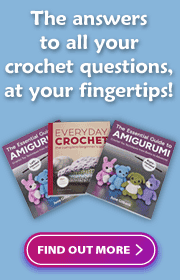Today’s PlanetJune Story comes from Susan McCarthy from Norfolk MA. I always love to see people using my potted plant crochet patterns in new and creative ways, and Susan’s fabulous multi-tier succulent display definitely fits that bill! I’ll let Susan explain: I belong to the Garden Club of Norfolk (Massachusetts) and each month someone signs […]

Archive for Category: PlanetJune Stories
PlanetJune Stories: Ann’s Giant Orca
Today’s PlanetJune Story comes from Ann Rowley in the UK. Ann first contacted me to ask for some advice on upsizing my Orca (Killer Whale) pattern to Giant scale. I cautioned that, in Giant scale, the Orca would take a lot of yarn and likely be over 3 feet long! Even so, Ann thought that […]
PlanetJune Stories: Going Postal!
Today’s PlanetJune Story comes from Hils Parker from Ickenham (in the London Borough of Hillingdon, UK), who made this amazing super-sized Discworld to top a post box earlier this year. Just look at this beauty! I really enjoyed seeing Hils making this amazing project (which she shared in the PlanetJune Discord group), and asked her […]
PlanetJune Stories: Diane’s Succulent Arrangements
Today’s PlanetJune Story comes from Diane Theriault from Boston, MA. Diane had the innovative idea to make needlepointed plastic canvas bases for my Succulent Collection crochet patterns, to make them into modular desk displays that can be arranged in multiple configurations, and combined into a giant window display. This is such a clever concept, and […]
PlanetJune Stories: Belinda’s Toasty Turtle
Today’s PlanetJune Story comes from Belinda from Australia. Belinda first contacted me when she’d made her turtle beach blanket and wanted some advice on the turtles, then she stayed in touch with her progress on the baby turtles, and her clever idea for a matching turtle heat pack. I knew you’d love to see this […]
PlanetJune Stories: Maureen’s Armadillo
Today’s PlanetJune Story comes from Maureen Carter, a crochet enthusiast from Grosse Pointe Woods, MI. Last year, Maureen tagged me on Facebook with this picture of an incredibly colourful armadillo she had crocheted using my pattern and based on a child’s drawing: …and I just had to reach out to her to find out more […]
PlanetJune Stories: CGOA Chapter Challenge
Today’s PlanetJune Story shows how easily you can brighten someone’s day with crochet. When Nancy Smith, the chairman for the Crochet Guild of America’s Chapter Challenge, contacted me in February to ask for permission for the CGOA to use my Love Hearts pattern as a way for their members to give back to their communities, […]
PlanetJune Stories: Dorte’s Fishbowl
Today’s PlanetJune Story comes from Dorte Jensen in Denmark, who used a selection of my crochet patterns to create this gorgeous realistic fishbowl! I’ll let Dorte explain how this project came to be: My husband saw your tropical fish patterns and said that they were so cute and that he wanted these fish made for […]














